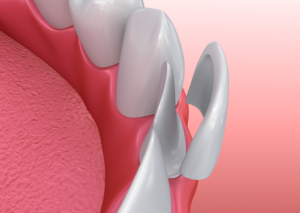How Much Enamel is Removed for Veneers?
March 24, 2023
 There are more options than ever before to address common aesthetic concerns, but porcelain veneers continue to rank among the most popular elective procedures every year. They can treat many imperfections at once using a minimally invasive procedure that can save time and money. However, your cosmetic dentist must remove some enamel to bond them to your teeth. Since your enamel can’t grow back, it’s normal to have concerns about altering your teeth. There’s no reason to worry because it doesn’t harm them. Your dentist will always take the conservative approach when prepping your teeth for veneers. Here’s how much enamel you can expect them to remove while on your journey to a picture-perfect smile.
There are more options than ever before to address common aesthetic concerns, but porcelain veneers continue to rank among the most popular elective procedures every year. They can treat many imperfections at once using a minimally invasive procedure that can save time and money. However, your cosmetic dentist must remove some enamel to bond them to your teeth. Since your enamel can’t grow back, it’s normal to have concerns about altering your teeth. There’s no reason to worry because it doesn’t harm them. Your dentist will always take the conservative approach when prepping your teeth for veneers. Here’s how much enamel you can expect them to remove while on your journey to a picture-perfect smile.
How Do Veneers Work?
A veneer is a customized thin shell that’s bonded to the front surface of a tooth to improve its color, size, and shape. When applied to the teeth visible when smiling, veneers can correct many imperfections simultaneously, like chips, cracks, discoloration, and gaps.
The process usually takes two appointments. During your first visit, your teeth are cleaned and prepared, which requires removing a small amount of enamel. Your dentist will then take an impression of your mouth to fabricate your custom-made veneers in a dental lab.
It can take the lab a couple of weeks to make them, so you’ll need temporary veneers while you wait. After your veneers are sent back to your dentist, you’ll return to have your temporary restorations removed and your permanent ones bonded to your teeth. You’ll walk out of the office with a dazzling smile that can last for a decade or longer with the correct care.
Why is Enamel Removed?
Enamel must be removed during the bonding process to ensure your veneers sit flush on your teeth. Not only does this create a stronger bond, but it also prevents any uncomfortable or unsightly ridges or ledges near the gum line for the edges of your teeth.
Typically, about 0.5 mm of enamel is removed, but the amount varies from patient to patient. Many factors will affect the etching process, like if your teeth have any ridges or grooves.
Your dentist will remove as little enamel as possible to preserve your natural smile. While the etching process does not harm your teeth, they must always be covered by restorations because they can be vulnerable to sensitivity, bacteria, and other issues without the added layer of protection.
Will Veneers Ever Need to Be Replaced?
Veneers are meant to provide long-lasting results. The unique etching process allows veneers to last for longer than ever, but there will come a time when they need to be replaced.
The average lifespan of veneers is about 10 years; however, it’s not unusual for them to last for much longer with the right maintenance, like brushing and flossing.
Although you’ll have to permanently alter your teeth to revamp your smile, it’s a small price to pay. The benefits of flawless teeth are priceless. You can turn the smile of your dreams into reality with porcelain veneers.
About Dr. Aaron Springhetti
Dr. Springhetti earned his dental degree from the University of Louisville School of Dentistry and has continued his education in advanced specialties, like cosmetic dentistry, general dentistry, and oral surgery. He strives to help each patient achieve their best smile. Request an appointment through our website or call (317) 886-1304.
No Comments
No comments yet.
RSS feed for comments on this post.
Sorry, the comment form is closed at this time.

